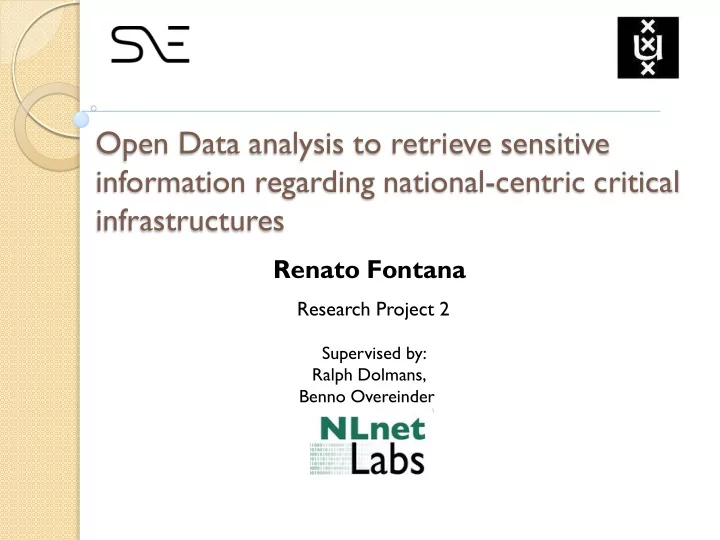

Open Data analysis to retrieve sensitive information regarding national-centric critical infrastructures Renato Fontana Research Project 2 Supervised by: Ralph Dolmans, Benno Overeinder
Presentation flow Introduction Known Studies Project Scope Visualization of Open Data ◦ Demo Conclusions & Future Work Questions Renato Fontana - Open Data Analysis 2
Introduction Open Data initiative ◦ Democratization of information; Sharing and collaboration; Application Development; Accountability; ◦ Freedom of Information Act; Source: OmgevingsAlert Empowers users; “The FOIA establishes for any person— corporate or individual, regardless of nationality — presumptive access to existing, unpublished agency records on any topic.” * ◦ Information disclosure; ◦ Sensitive content; * Critical Infrastructure Information Disclosure and Homeland Security, DTIC 2002. Renato Fontana - Open Data Analysis 3
Introduction Critical Infrastructures ◦ What is critical ? “Essential services that contribute to the stability and security of a Country” – Rinaldi 2001 Nation dependent CI Protection ◦ National Security information ◦ Information classification; Sensitive but unclassified ◦ Openness vs Secrecy Renato Fontana - Open Data Analysis 4
Research question ◦ Can users make use of Open Data databases to retrieve country sensitive information? ◦ How can this information be visually represented in a way that allows the easy identification of critical and strategically important areas on detailed level? Renato Fontana - Open Data Analysis 5
Known studies No studies in the visual representation of CI areas based on open data. “The risk of public data availability on critical infrastructure protection”. Abbas, 2006. ◦ Compilation of SBU information; “Empirical findings on critical infrastructure dependencies in Europe”. Luiijf , 2009. ◦ Analysis on public reports of CI disruption events to recognize cascading effects. “Mapping the Dutch Critical IP Infrastructure”. Alizadeh and Oprea, 2013. ◦ Dutch Critical Infrastructures organizations rely on foreign communication providers – based on public knowledge. Renato Fontana - Open Data Analysis 6
Project Scope Limited to Netherlands; ◦ Existing repositories in National and City levels; ◦ Country classification of CI; Limited dataset analysis; ◦ Most relevant data reflecting CI; Telecommunication & ICT; Energy Resources; Visual representation; ◦ Pattern recognition; Renato Fontana - Open Data Analysis 7
Open Data - Netherlands Current view ◦ Netherlands 6 th in OKFN rank. Multiple reliable repositories; ◦ Government, private sector and user maintained; data.overheid.nl; maps.amsterdam.nl,; alliander.nl; data.amsterdamopendata.nl; Other public sources; Machine readable; ◦ .csv, .xls, .json, live APIs; Renato Fontana - Open Data Analysis 8
Dutch Critical Infrastructures Dutch government on the CIP identify the following as critical infrastructures Energy Health Legal Order ICT Transportation Financial Chemical, Water supply Public Order Nuclear and Safety Industries Public Food Chain Administration Source: government.nl/issues/crisis-national-security-and-terrorism Renato Fontana - Open Data Analysis 9
Approach Create hypothesis and visualizations; ◦ Relevant CI Datasets; ◦ Experimentation; ◦ Gain insights; Feedback loop process. Keim,2008 Renato Fontana - Open Data Analysis 10
Visualization of Open Data Data Acquisition ◦ Web crawlers, visual inspection, search engines, manual download of contents; Data Sanitation ◦ Removal of arbitrary and blank entries; Project scope; Layer creation ◦ Visual representation of datasets to CI categories; Quickly identification of patterns Renato Fontana - Open Data Analysis 11
Data Analysis Initial data inspection; ◦ Common localization identifier among datasets ◦ PostCode, Coords, LAT, LONG, City, locatie, buurt, wijk, gem Map representation; ◦ Shape Files (.shp) parse; Centraal Bureau voor de Statistiek – cbs.nl Convert to .kml ◦ Google Maps API; Geocoding, Fusion Tables Renato Fontana - Open Data Analysis 12
Demonstration Renato Fontana - Open Data Analysis 13
Findings Patterns on CI; ◦ Identified cities; Amsterdam, Den Haag, Rotterdam; ◦ Data Centers and Power Plants NL-IX peering DCs, Hemweg PowerPlant; ◦ High resource demanding areas Westpoort, Sloterdijk, De Omval, Bullewijk Details on electric consumption; ◦ Business offices and companies AMSTERDAM,1101A Afgeschermd AMSTERDAM,1101B Afgeschermd ◦ Interest in hiding data AMSTERDAM,1101C 22.961.527 Renato Fontana - Open Data Analysis 14
Conclusions Compilation of public information; ◦ Not trivial; Sufficient insights from CI; ◦ Specific layers; ◦ Limited amount of time; Openness vs Secrecy; ◦ Hidden values Proper classification of information; Critical Infrastructure Protection risk; ◦ Multiple areas with overlapping events ◦ Possible correlation Renato Fontana - Open Data Analysis 15
Future work Research scoped to Netherlands; ◦ Further cities: Den Haag; Rotterdam; ◦ Additional dataset and sources; Real-time APIs; Automated approaches; ◦ Machine learning; ◦ Artificial Intelligence; Ongoing country profiling; ◦ Business purposes; Open Discussion ◦ Beneficial or Dangerous ? Renato Fontana - Open Data Analysis 16
Questions ? Renato Fontana - Open Data Analysis 17
Recommend
More recommend